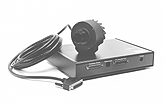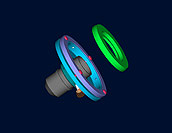 1. ST-237A - 16 bit version now available
1. ST-237A - 16 bit version now availableAnnouncement
New Products In Development
April 16, 2001
[Updated November 26, 2001]
This announcement is to provide advance information about new products that we expect to release over the next few months. These are products under development and as such we do not have any further technical information, prices or specific release dates to give out other than what is posted in this announcement. When a product matures to the point that we can post more technical data, etc., we will update our web site. As always we appreciate your comments and suggestions for improving our product line.
 1. ST-237A - 16 bit version now available
1. ST-237A - 16 bit version now available
The ST-237 has been upgraded to a 16 bit A/D and designated the Model ST-237A. In addition to the new A/D, the ST-237A also includes, at no additional cost, CCDSoftV5 and CCDSharp software. CCDSharp software normally sells for $149.00. CCDSoftV5 normally sells for $350.00. PlanetMaster software is also available for the ST-237A at no additional cost. The ST-237A is an excellent camera with very high quantum efficiency and a reasonable price. The CCD array is 657 x 495 pixels at 7.4 microns square making it well suited to shorter focal length telescopes and particularly well suited to Celestron's Fastar line of telescopes. The ST-237A drivers have been updated to take advantage of all the pixels on the TC237 detector resulting in a slightly larger field of view and pixel count. The camera has an internal shutter wheel for automatically taking dark frames without the need to cover the camera or the telescope. An optional internal color filter wheel that fits inside the 3.5" head is available for automatic tri-color imaging using the supplied software. List price of the ST-237A is $1295.
To see more information on the ST-237A click here.
To see sample images from the ST-237 camera click here.
 2.
ST-1001E
2.
ST-1001E
Historically, SBIG has endeavored to offer scientific quality CCD cameras at an affordable price. The new ST-1001E is the latest step along that path. The ST-1001E is our largest area array to date. Utilizing the Kodak Enhanced Blue Plus KAF-1001E detector with 1024 x 1024 pixels at 24 microns, this CCD has nearly 5 times the imaging area of the ST-8. With large pixels, high QE, low noise and a large imaging area, this camera is ideal for long focal length telescopes, supernova search programs, minor planet detection, automated operation and other applications requiring the extra sensitivity of large pixels and a relatively large field of view. Because the detector is nearly one inch square, the second guiding CCD found in the ST-7/8/9/10 has been removed from the camera head. For users requiring an autoguider, a special package will be offered with the very capable STV bundled as the autoguider. We are not yet accepting orders, however we expect to be in production this summer. When we have a better idea of the actual production date we will update this announcement and start taking orders. List price on November 26, 2001, is $6595.
Update May 16, 2001: We have are now accepting orders for the ST-1001E. Production began September, 2001. For more information and current pricing on the ST-1001E click here.

Megapixel detectors such as the KAF-3200E used in the new ST-10E do take time to download at full frame high resolution mode through the parallel interface which we developed some years ago for smaller detectors. SBIG is committed to developing a high speed interface for these larger arrays. We are currently developing USB to replace the current standard parallel interface. The USB version will be available as an upgrade to our current head design. Our previous reluctance to use USB has been mitigated by the introduction of a variety of relatively inexpensive USB extenders that will allow the camera to be operated at a more remote distance from the computer than the straight USB cable limit will allow. While we did not want to wait to release the high resolution ST-10E with 3 million pixels in our current parallel based design, we are aware that some users are concerned about the pending improvements we have planned. Therefore, to allay any fears that a faster version of our megapixel cameras might be just around the corner to obsolete the current parallel versions, SBIG will provide the upgrade to USB, when it is ready for release, at no additional cost to ST-10E owners. ST-7, ST-8 and ST-9 owners will be able to upgrade to a USB version of the camera, if desired, at a reasonable cost. We hope to have the USB interface completed before the end of this year.
Update November 26, 2001: The prototype analog and digital boards are done. We are debugging these before sending the camera to FCC for approval. We now estimate that the first production units will be available in March.
The "Super-eFinder" is a fast, wide-field, optical tube assembly specifically designed for use with CCD cameras as an electronic finder lens or wide field imaging lens. The 4" diameter F/2.8 optical tube assembly is a Houghton design that uses a doublet corrector lens plus a mirror to achieve near apo performance in a compact package. The OTA is approximately 6.5" long (without the dew cap). This lens design will fully illuminate an STV, ST-237 or ST-7E. It will also cover an ST-8E CCD, but with some vignetting and loss of image quality near the edge of the field. Prototype testing is underway.
Update November 26, 2001: This product has been placed on a temporary hold while we put all our efforts into getting the USB interface completed.
 5. Quick Disconnect Accessoryt for SCTs.
5. Quick Disconnect Accessoryt for SCTs.
The Quick Disconnect accessory allows you to easily rotate, remove and replace the CCD camera head after it has been firmly attached to your telescope and brought to good focus. The quick disconnect works by simply squeezing two large rings together. When the rings are released the camera head stays put. The camera head can be removed and a second ring holding an eyepiece can be attached for locating objects. When the camera is returned to the telescope it is still in focus. The accessory includes a small base ring for the telescope, one set of clamping rings for the CCD camera head and one set of clamping rings with a 1.25" drawtube and eyepiece (shown in the rendering above). Prototype testing is underway.
Update November 26, 2001: We are now accepting orders for this accessory. Units are in stock. Click here for more information.
The autofocus accessory is a slim focusing mechanism that is both accurate and strong. Focusing is achieved automatically by software driving the autofocus mechanism. Prototype testing is underway.
Update November 26, 2001: This product has been placed on a temporary hold while we put all our efforts into getting the USB interface completed.
Please keep in mind that this is an advance notice and the information can and probably will change as we work on these projects. As soon as we have firm release dates, technical specs and firm prices we will post the information on our web site.
Revised: November 26, 2001 02:41:43 PM.
Copyright © 2001 Santa Barbara Instrument Group, Inc. All rights reserved.
Please report any problems with this page directly to the Webmaster